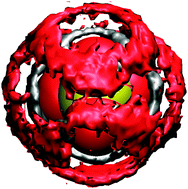Solvation and ion-pairing properties of the aqueous sulfate anion: explicit versus effective electronic polarization†
Abstract
We assessed the relative merits of two approaches for including polarization effects in classical force fields for the sulfate anion. One of the approaches is the explicit shell model for atomic polarization and the other is an implicit dielectric continuum representation of the electronic polarization, wherein the polarizability density is spatially uniform. Both the solvation and ion association properties of sulfate were considered. We carried out an ab initio molecular dynamics simulation for a single sulfate anion in aqueous solution to obtain a benchmark for the solvation structure. For the ion-pairing properties, the models were compared to experimental thermodynamic data through Kirkwood–Buff theory, which relates the integrals of the pair correlation functions to measurable properties. While deficiencies were found for both of the approaches, the continuum polarization model was not systematically worse than the shell model. The shell model was found to give a more structured solution than the continuum polarization model, both with respect to solvation and ion pairing.


 Please wait while we load your content...
Please wait while we load your content...